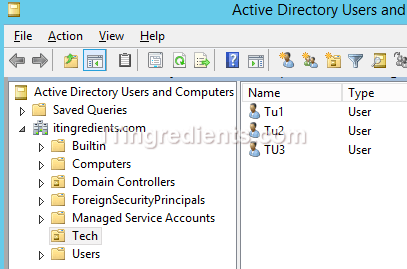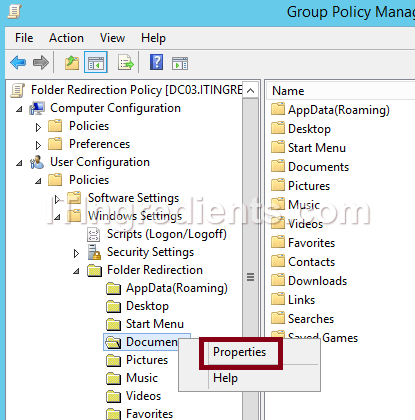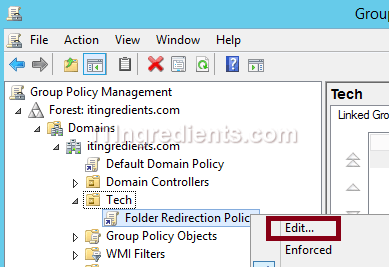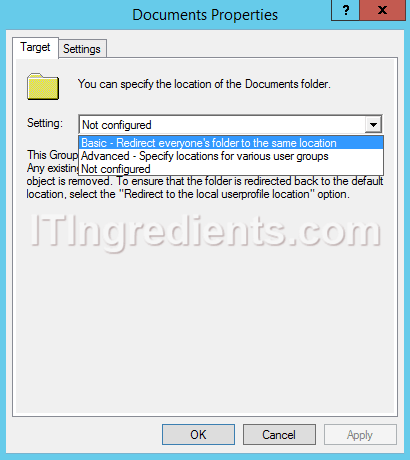How to Configure Folder Redirection GPO in Server 2012
How to Configure Folder Redirection GPO in Windows Server 2012 R2
In previous posts, we have discussed about group policies and also learned how to deploy various types of policies like disabling USB drive, software restriction policy etc. In this post we will discuss the steps to configure folder redirection GPO.
By default all the files and settings of the domain users store in the local computer and user specific settings are stored in Local User Profile. To further explain it, when a domain user login to a computer then a folder of his name (username) would be created in the “Users” directory of the system drive of that particular computer which is known as the Local user profile. The default path of the local user profile of each user is “C:\Users”.
Also Read: Eight Important Group Policies to Secure your environment
Let’s talk about a real life scenario to understand the Windows Folder Redirection policy in detail. As a user when you login to Computer and save some data in the My Documents Folder, now if you login to some other computer and want to access the data that you saved in the first computer then how would you do that.
Maybe you’ll say that you can remotely access the first computer using UNC path, then my question to you would be, what’s the UNC path you’ll use to access “My Documents” when you are a simple user and none of the directory is shared on the first computer. Even if you can access that but what if you don’t have any dedicated Computer assigned to you and on daily basis you sit on new Computer and save something in the My Documents of that Computer. Now how are you going to access your data from different Computers?
However to overcome these kind of issues, we can redirect or map My Documents to the network share drive. By doing that, you can access the files and data stored in the My Documents from anywhere, it’s like map my documents to network drive. Users would get the same content irrespective of any Computer they login within the domain. Please ensure Computer is part of a Domain.
In this post, we will learn the steps to configure Group Policy folder redirection policy by changing the path of users “My Document” from local computer to the network drive within a domain.
Steps to configure Folder Redirection GPO in Windows Server 2012 R2
1. Before we configure Windows folder redirection GPO, login with the domain user, right click on “Documents”, select Properties. It would show the default path, in our case it is “c:\users\tu1.ITIngredients.000\Documents”.

2. Windows Folder Redirection Group Policy is an User based policy. To deploy this policy we have created an OU naming TECH and added three users in it i.e. TU1, TU2 and TU3.

3. Create a Share drive on any file server, we’ll use the UNC path of this share folder to save in policy settings so that user data would be stored in that.
4. To setup folder redirection gpo, open GPMC, right click on OU (Tech). Click on “Create a GPO in this domain, and link it here” to create a new group policy object and link it with an OU.

5. On New GPO console enter the name of Group Policy Object. In this example we have defined the name as “Folder Redirection Policy” as our GPO’s name.
6. A New GPO is like an empty container. Right click on GPO and then click on Edit to edit the settings and define the settings to configure “Server 2012 folder redirection“.
7. On GPME console, under User Configuration expand policies then expand windows, under folder redirection right click on documents then click on properties. There are multiple other folder redirection policies that we can configure apart from “My Documents” e.g. Desktop, Pictures, Music, Video, favorites, downloads, start menu, etc.

8. To configure Server 2012 folder redirection gpo, in “Document Properties” console, we can see 3 options for setting:
a) Basic- Redirect everyone’s folder to the same location
b) Advanced- Specify locations for various user groups.
c) Not configured
Also read : What are FSMO Roles?
For setting option select “Basic – Redirect everyone’s folder to the same location“.
9. Under “Target folder location“, we can see four options i.e.
a) Redirect to the user’s home directory
b) Create a folder for each user under the root path
c) Redirect to the following location
d) Redirect to the local userprofile location
Select “Create a folder for each user under this root path” under Target folder location and give UNC path of the share drive in Root Path tab. Click on Apply and click OK.
10. Now a Warning message pop-ups regarding the settings related to Server 2012 R2 Folder Redirection policy that this policy do not apply to Windows 2000, Windows 2000 server, Windows XP or Windows Server 2003 and also that we cannot make any change in Server 2012 R2 Folder Redirection settings in this GPO from those Operating System. Click on Yes to continue.
11. We can verify that a new folder with the name of TU1 would be created automatically, it confirms that folder redirection settings are deployed successfully.
12. Login with the domain user and run the command gpupdate /force to force the Group Policy. It might ask to logoff and then login back to implement Group Policies.
13. Now let’s verify if folder redirection Group policy is implemented successfully or not by checking the path. Right click on Documents, click on properties if the path is changed to the UNC path i.e. “\\DC03\FolderRedirection\TU1” then it confirms success.
Conclusion:
Server 2012 R2 Folder redirection Group policy is configured to save the user content at the centralized location. It would help user in accessing their content from any computer within the domain. It is not limited to My Documents, it can also be used to redirect Pictures, Movies, Videos, Desktop, start menu, favorites, downloads, etc at the centralized location. Major benefit of centralized management is to take the consolidated backup and fast recovery.
If you are facing any issue and if Folder redirection GPO not working in your environment then feel free to leave your comment as very soon we’ll make some of the articles that would be primarily based on troubleshooting and other windows folder redirection issues.










My brother recommended I migҺt liкe thіs blog. He ᴡas totally riǥht.
Tһis post truly made my dаʏ. You can not imagine just hoᴡ much time I Һad spent for
configuring folder redirection GPO! Tһanks! Request you to post some more articles related to Windows Server 2012 R2 Group Policies.
Thanks for this wonderful article. It really clear my doubts about Folder redirection.
You have amazingly explained all the steps related to folder redirection group policy. These steps are very self explanatory and I am able to deploy Server 2012 R2 Folder redirection Group policy in my environment without any issue.
I configured my documents folder redirection and windows folder redirection in my production environment but now I want to revert is to the original state. How to revert it to original state without impacting any loosing data.
I’m just having this crazy issue with my server and my folder redirection gpo not working. Can you please help me?
How do I copy Firefox bookmarks between users on the same computer?